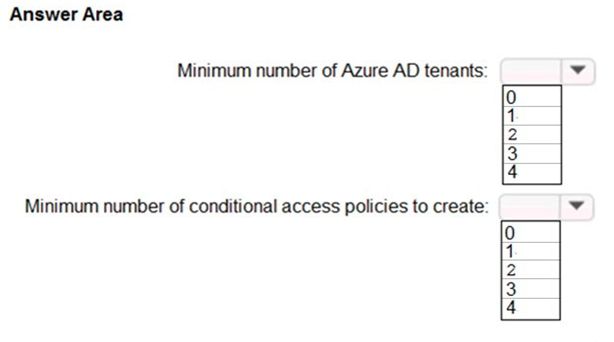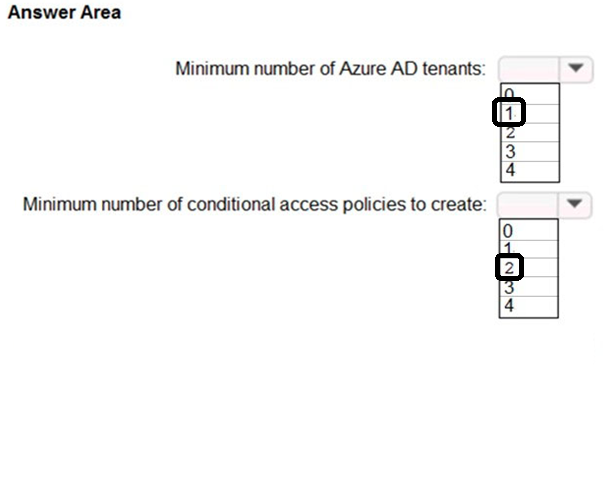| Question.66 HOTSPOT Case Study This is a case study. Case studies are not timed separately. You can use as much exam time as you would like to complete each case. However, there may be additional case studies and sections on this exam. You must manage your time to ensure that you are able to complete all questions included on this exam in the time provided. To answer the questions included in a case study, you will need to reference information that is provided in the case study. Case studies might contain exhibits and other resources that provide more information about the scenario that is described in the case study. Each question is independent of the other questions in this case study. At the end of this case study, a review screen will appear. This screen allows you to review your answers and to make changes before you move to the next section of the exam. After you begin a new section, you cannot return to this section. To start the case study To display the first question in this case study, click the Next button. Use the buttons in the left pane to explore the content of the case study before you answer the questions. Clicking these buttons displays information such as business requirements, existing environment, and problem statements. If the case study has an All Information tab, note that the information displayed is identical to the information displayed on the subsequent tabs. When you are ready to answer a question, click the Question button to return to the question. Overview Fabrikam, Inc. is an engineering company that has offices throughout Europe. The company has a main office in London and three branch offices in Amsterdam, Berlin, and Rome. Existing Environment: Active Directory Environment The network contains two Active Directory forests named corp.fabrikam.com and rd.fabrikam.com. There are no trust relationships between the forests. Corp.fabrikam.com is a production forest that contains identities used for internal user and computer authentication. Rd.fabrikam.com is used by the research and development (R&D) department only. The R&D department is restricted to using on-premises resources only. Existing Environment: Network Infrastructure Each office contains at least one domain controller from the corp.fabrikam.com domain. The main office contains all the domain controllers for the rd.fabrikam.com forest. All the offices have a high-speed connection to the internet. An existing application named WebApp1 is hosted in the data center of the London office. WebApp1 is used by customers to place and track orders. WebApp1 has a web tier that uses Microsoft Internet Information Services (IIS) and a database tier that runs Microsoft SQL Server 2016. The web tier and the database tier are deployed to virtual machines that run on Hyper-V. The IT department currently uses a separate Hyper-V environment to test updates to WebApp1. Fabrikam purchases all Microsoft licenses through a Microsoft Enterprise Agreement that includes Software Assurance. Existing Environment: Problem Statements The use of WebApp1 is unpredictable. At peak times, users often report delays. At other times, many resources for WebApp1 are underutilized. Requirements: Planned Changes Fabrikam plans to move most of its production workloads to Azure during the next few years, including virtual machines that rely on Active Directory for authentication. As one of its first projects, the company plans to establish a hybrid identity model, facilitating an upcoming Microsoft 365 deployment. All R&D operations will remain on-premises. Fabrikam plans to migrate the production and test instances of WebApp1 to Azure. Requirements: Technical Requirements Fabrikam identifies the following technical requirements: Website content must be easily updated from a single point. User input must be minimized when provisioning new web app instances. Whenever possible, existing on-premises licenses must be used to reduce cost. Users must always authenticate by using their corp.fabrikam.com UPN identity. Any new deployments to Azure must be redundant in case an Azure region fails. Whenever possible, solutions must be deployed to Azure by using the Standard pricing tier of Azure App Service. An email distribution group named IT Support must be notified of any issues relating to the directory synchronization services. In the event that a link fails between Azure and the on-premises network, ensure that the virtual machines hosted in Azure can authenticate to Active Directory. Directory synchronization between Azure Active Directory (Azure AD) and corp.fabrikam.com must not be affected by a link failure between Azure and the on-premises network. Requirements: Database Requirements Fabrikam identifies the following database requirements: Database metrics for the production instance of WebApp1 must be available for analysis so that database administrators can optimize the performance settings. To avoid disrupting customer access, database downtime must be minimized when databases are migrated. Database backups must be retained for a minimum of seven years to meet compliance requirements. Requirements: Security Requirements Fabrikam identifies the following security requirements: Company information including policies, templates, and data must be inaccessible to anyone outside the company. Users on the on-premises network must be able to authenticate to corp.fabrikam.com if an internet link fails. Administrators must be able authenticate to the Azure portal by using their corp.fabrikam.com credentials. All administrative access to the Azure portal must be secured by using multi-factor authentication (MFA). The testing of WebApp1 updates must not be visible to anyone outside the company. To meet the authentication requirements of Fabrikam, what should you include in the solution? To answer, select the appropriate options in the answer area. NOTE: Each correct selection is worth one point.  |
66. Click here to View Answer
Answer:

| Question.67 You have an Azure subscription that contains an Azure Blob Storage account named store1. You have an on-premises file server named Server1 that runs Windows Server 2016. Server1 stores 500 GB of company files. You need to store a copy of the company files from Server1 in store1. Which two possible Azure services achieve this goal? Each correct answer presents a complete solution. NOTE: Each correct selection is worth one point. (A) an Azure Logic Apps integration account (B) an Azure Import/Export job (C) Azure Data Factory (D) an Azure Analysis services On-premises data gateway (E) an Azure Batch account |
67. Click here to View Answer
Answer: BC
B: You can use the Azure Import/Export service to securely export large amounts of data from Azure Blob storage. The service requires you to ship empty drives to the Azure datacenter. The service exports data from your storage account to the drives and then ships the drives back.
C: Big data requires a service that can orchestrate and operationalize processes to refine these enormous stores of raw data into actionable business insights.
Azure Data Factory is a managed cloud service that’s built for these complex hybrid extract-transform-load (ETL), extract-load-transform (ELT), and data integration projects.
Reference:
https://docs.microsoft.com/en-us/azure/storage/common/storage-import-export-data-from-blobs https://docs.microsoft.com/en-us/azure/data-factory/introduction
| Question.68 Note: This question is part of a series of questions that present the same scenario. Each question in the series contains a unique solution that might meet the stated goals. Some question sets might have more than one correct solution, while others might not have a correct solution. After you answer a question in this section, you will NOT be able to return to it. As a result, these questions will not appear in the review screen. You need to deploy resources to host a stateless web app in an Azure subscription. The solution must meet the following requirements: Provide access to the full .NET framework. Provide redundancy if an Azure region fails. Grant administrators access to the operating system to install custom application dependencies. Solution: You deploy a web app in an Isolated App Service plan. Does this meet the goal? (A) Yes (B) No |
68. Click here to View Answer
Answer: B
Instead: You deploy two Azure virtual machines to two Azure regions, and you create an Azure Traffic Manager profile.
Note: Azure Traffic Manager is a DNS-based traffic load balancer that enables you to distribute traffic optimally to services across global Azure regions, while providing high availability and responsiveness.
Reference:
https://docs.microsoft.com/en-us/azure/traffic-manager/traffic-manager-overview
| Question.69 You need to recommend a solution that meets the data requirements for App1. What should you recommend deploying to each availability zone that contains an instance of App1? (A) an Azure Cosmos DB that uses multi-region writes (B) an Azure Data Lake store that uses geo-zone-redundant storage (GZRS) (C) an Azure Storage account that uses geo-zone-redundant storage (GZRS) |
69. Click here to View Answer
Answer: A
Scenario: App1 has the following data requirements:
Each instance will write data to a data store in the same availability zone as the instance.
Data written by any App1 instance must be visible to all App1 instances.
Azure Cosmos DB: Each partition across all the regions is replicated. Each region contains all the data partitions of an Azure Cosmos container and can serve reads as well as serve writes when multi-region writes is enabled.
Incorrect Answers:
B, D: GZRS protects against failures. Geo-redundant storage (with GRS or GZRS) replicates your data to another physical location in the secondary region to protect against regional outages. However, that data is available to be read only if the customer or Microsoft initiates a failover from the primary to secondary region.
C: Active geo-replication is designed as a business continuity solution that lets you perform quick disaster recovery of individual databases in case of a regional disaster or a large scale outage. Once geo-replication is set up, you can initiate a geo-failover to a geo-secondary in a different Azure region. The geo-failover is initiated programmatically by the application or manually by the user.
Reference:
https://docs.microsoft.com/en-us/azure/cosmos-db/high-availability
| Question.70 You have an on-premises application named App1 that uses an Oracle database. You plan to use Azure Databricks to transform and load data from App1 to an Azure Synapse Analytics instance. You need to ensure that the App1 data is available to Databricks. Which two Azure services should you include in the solution? Each correct answer presents part of the solution. NOTE: Each correct selection is worth one point. (A) Azure Data Box Gateway (B) Azure Import/Export service (C) Azure Data Lake Storage (D) Azure Data Box Edge (E) Azure Data Factory |
70. Click here to View Answer
Answer: BE
Data Factory is a data integration service that provides a low-code or no-code approach to construct extract, transform, and load (ETL) processes within a visual environment or by writing your own code.
Exporting data, either to another data technology or to another Dataverse environment, can use any of the same technologies for importing data, such as dataflows, Data Factory, Power Query, and Power Automate.
Reference:
https://docs.microsoft.com/en-us/power-apps/maker/data-platform/import-export-data
